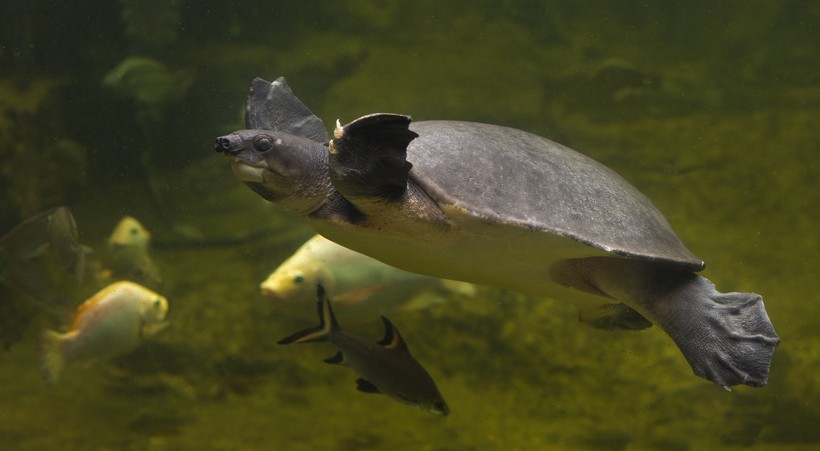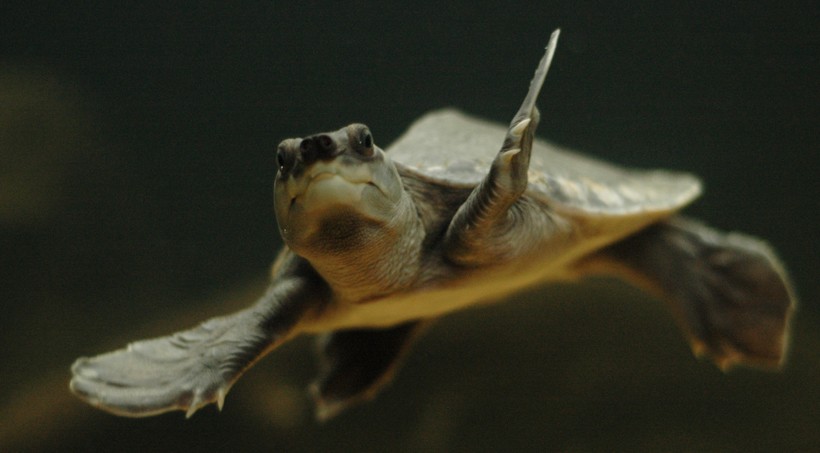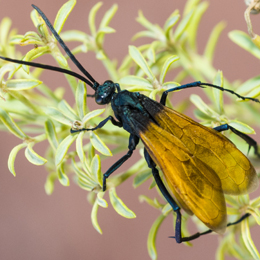Description
One look at these beautiful, exotic creatures and you will see why they are called the pig-nosed turtles. Their big nostrils and fleshy snouts resemble that of pigs. They are also called Fly River turtle because of their habitat. Fly River is a river in Papua New Guinea and is one of the habitats of pig-nosed turtles.
The shells (carapaces) of pig-nosed turtles are gray to olive green, and their bottom shells (plastrons) are yellow, white or cream colored. When the plastron turns red, it signifies the poor quality of water that may lead to its eventual death.
Sexual dimorphism is not very pronounced in the initial years of pig-nosed turtles. Once they are 10 years of age, and their top shell reaches around 25 cm, differences become more obvious. Male pig-nosed turtles are relatively smaller than the females of the same age. Also, males have longer and thicker tails than the female pig-nosed turtles. This characteristic helps us easily to identify male pig-nosed turtles.

Pig-nosed turtles are the only freshwater turtles that have flippers similar to marine turtles.
?
Image credits: reptiles4all/Shutterstock
These adorable creatures live up to 25 to 30 years in the wild. Under good conditions in captivity, pig-nosed turtles can even live up to 40 years of age. Adult pig-nosed turtles can measure up to 70 cm and can weigh up to 20 kg. The carapace or the upper shell is leathery and bony. The plastron or bottom shell is hard and is connected to the upper shell via bones.
One of the most interesting traits of pig-nosed turtles is, you may guess it, the nose. They have a strong sense of smell. The nose acts like a snorkel that they use to breathe in water, and to find their food.
Pig-nosed turtles are regarded as a rare species. They are the only surviving members of the Carettochelyidae family, a family that was once distributed widely during the Tertiary period. Pig-nosed turtles do not have any known subspecies. Some studies suggested that there are two subspecies, however, these proposals have been rejected.
Anatomy and Characteristics
Pig-nosed turtles are large turtles that can grow up to 70 cm. They are also heavy-bodied creatures that can weigh around 20 kg. Pig-nosed turtles have grayish brown or olive-grey bodies with a white plastron (bottom shell). They have whitish blotches around the eyes. The upper shell is streamlined and covered with soft, leathery and pitted skin. Beneath this leathery skin, pig-nosed turtles retain a domed bony carapace. The upper and bottom shells lack scutes - the hard, bony protective cover.

Pig-nosed turtles are large turtles that can grow up to 70 cm.
?
Image credits: Paulo Resende/Shutterstock
They are freshwater turtles and look similar to sea turtles. Their forelimbs resemble flippers, making pig-nosed turtles remarkably swimmers. They use their webbed hind limbs for steering and paddling. Each limb has two claws.
Habitat
Pig-nosed turtles are entirely aquatic creatures. The female turtles leave the water only to nest, and quickly return to the water once the eggs are laid. The turtles inhabit freshwaters such as rivers, lakes, swamps, streams, lagoons, and water holes. They tend to go into the water as deep as seven meters. They also inhabit estuaries and deltas. Pig-nosed turtles prefer gravel and sand covered litter and silt.

The turtles inhabit freshwater such as rivers, lakes, swamps, streams, lagoons, and water holes.
?
Image credits: Nicholas Toh/Shutterstock
Pig-nosed turtles are primarily found in northern Australia and southern New Guinea. They may be seen also in Irian Jaya, Indonesia. During winter, they thrive in water temperatures between 31 and 32 degrees Celsius and temperatures between 26 and 28 degrees Celsius during summers. They prefer limestone rivers that show a relatively high pH that remains around 8.2 during the dry season, and around 7.5 during the wet season. They are restricted to rivers with high conductivity.
Diet
Although omnivorous, pig-nosed turtles eat more plants than animal originated material showing thus a herbivorous tendency. They typically eat fruits and leaves from the wild fig and other plants growing along the river banks.
Pig-nosed turtles also eat worms, mollusks, crustaceans, and small fish. Infant pig-nosed turtles are believed to eat more animal matter than adults. Besides acting as a snorkel, the long snout helps the turtles also to locate their prey in the sand or murky waters.

Although omnivorous, the turtle diet contains mostly organic material
?
Image credits: Sukpaiboonwat/Shutterstock
Sea and river crocodiles are the main predators of pig-nosed turtles. Buffaloes, monitor lizards, and wild pigs may raid their nests to destroy the eggs or trample the young ones on the river banks. This is one of the reasons for population decline.
Reproduction and Life Cycle
Female pig-nosed turtles reach sexual maturity around 18 years of age, and males around 16 years. At maturity, their carapace length is around 25-30 cm. The mating of pig-nosed turtles has not been documented in detail. Females lay eggs during the dry season. Dry, clean, sandy areas near the water are chosen for nesting. The nesting period is between September and February for the pig-nosed turtles of New Guinea, and between July and November for the Australian populations. The nest is built by the females during the night. The nest is a shallow chamber of about 22 cm in depth and is built in sand or mud, up to five meters from the shore.
Every second year, females lay two clutches during the dry season. Each clutch contains 7 to 39 eggs. However, larger clutches have been observed only in areas where more than one female uses the same nesting site. The eggs are deposited in the nest during the night and are white and spherical with a diameter of about 39 mm, weighing around 35 gram. Unlike the marine turtles, pig-nosed turtles do not use their front flippers during nesting. The nesting area is not defended as the females leave the place directly after laying the eggs.

During the dry season, pig-nosed turtles gather in a dense aggregation
?
Image credits: Erik W. Grow/Shutterstock
The incubation period is about 65 to 103 days at a temperature of around 30 degree Celsius. At times, the fully developed embryo may have a delayed hatching and require a stimulated hatching through flooding or rain. The incubation temperature determines the sex of the offspring. Relative low temperatures induce male pig-nosed turtles whereas higher temperatures result in females.
Most young ones leave the eggs during midnight. The first heavy rainfall triggers the process of hatching. Hatchlings are between 5 and 6 cm long and show a pink plastron (bottom shell). They have a high vertebral keel because of the development of the embryo in folded position in the egg. Small tubercles that resemble scutes are present in the keel. The keels become less obvious with time when the pig-nosed turtles reach maturity.
At the time of hatching, there are lateral serrations on the border of the upper shell. These serrations become stiff after the first week and disappear after a couple of months.
Behavior and Intelligence
In wild, the pig-nosed turtles are believed to be a social species. They are seen to be highly aggressive with each other and other turtles. The turtles tend to move around based on seasoning switches. During the dry season, when the water level is decreased and the rivers show intermittent pools of water, pig-nosed turtles tend to agglomerate to a dense level. On the other hand, during the wet season they move to deep water, and migrate to estuaries. Female pig-nosed turtles move together during the period when they are depositing their eggs. They communicate with each other to make sure they find and reach the safest areas for their nests.

They have sensitive noses that are used to breathe, and to identify their food.
?
Image credits: Paulo Resende/Shutterstock
Pig-nosed turtles are active during day and night. In one of the studies, it was also noted that females are more active than male pig-nosed turtles. The home range for a female is around 8 km on average, while this is only approximately 3 km for a male. Unlike other freshwater turtles, pig-nosed turtles do not swim but row in water using their paddle-like flippers.
They have sensitive noses that are used to breathe and identify their food. The eyes are used for visual perception but become a secondary sensory role in turbid waters. With well-developed ears, pig-nosed turtles can hear an extensive range of frequencies.
Unfortunately, very limited information is available about the communication practices among pig-nosed turtles.
Population and Conservation Status
Pig-nosed turtles inhabit the fresh waters of northern Australia, southern New Guinea, and Irian Jayan. The Australian population remains isolated from the populations of New Guinea and Irian Jayan. The total population size of pig-nosed turtles is not known. However, studies in the Daly River drainage estimate that there are about 3000 pig-nosed turtles in Australia. The studies also show that a high-density area inhabits about 7 pig-nosed turtles per kilometer on average, whereas this is 2 for low-density areas. The total population sizes in New Guinea and Irian Jayan are not known.
Pig-nosed turtles are vulnerable species, according to the IUCN Red List. There has been a steep decline (more than 50%) in the population of the pig-nosed turtles since 1981. Large-scale exploitation of these creatures for meat and eggs is one of the main reasons for this decline in population. Another reason is that the turtle eggs as present near river beds are destroyed by water buffaloes that come to the river for taking a bath.

According to the IUCN Red List, Pig-nosed turtles are vulnerable species.
?
Image credits: LIUSHENGFILM/Shutterstock
Additionally, the natural habitats of pig-nosed turtles are disappearing fast and, therefore, threatening the existence of these wonderful creatures. Likewise, the river water is becoming polluted often because of activities of nearby factories and mines. This polluted water is also a major threat for pig-nosed turtles.
Their unique appearance makes pig-nosed turtles popular in the pet markets. They are exported as pets to different countries, such as Japan. Illegal trade of these protected species is curtailed in an attempt to increase their number.
In New Guinea, the indigenous people capture the turtles using nets, spears, traps or using bare hands. They are collected for their eggs and meat.
Since they are the only surviving members of the species, scientists and conservationists are trying hard to conserve this species along with other creatures that live in the same habitat. Efforts are being made to protect the natural habitats of the pig-nosed turtles. Research studies are currently carried out to find strategic methods for the conservation of pig-nosed turtles.
Evolutionary History
Since they have similar characteristics as marine turtles, many researchers believe that pig-nosed turtles might be the missing link between the marine and freshwater turtles.
Pig-nosed turtles, according to doctoral student Joshua Lively, may have been originated from Arvinachelys goldeni. This strange-looking turtle lived during the Cretaceous period, around 79 million years ago. Fossil material of this Arvinachelys goldeni was recently found in Utah.
The most striking characteristic of Arvinachelys goldeni is its pig-like nose. Turtles typically have a single opening in the nose, whereas Arvinachelys goldeni had double, making the ancient species extremely unique. The Arvinachelys goldeni species lived along with armored ankylosaurs and tyrannosaurs.
Funfacts
- Pig-nosed turtles spend most of their lives in water, and come to land only to lay eggs.
- They are the only freshwater turtles that have flippers similar to the marine turtles.
- Adult pig-nosed turtles thermo-regulate themselves in water by making themselves comfortable on the river bottom over small thermal springs.
- Pig-nosed turtles are opportunistic omnivorous having herbivorous tendencies.
- The eggs of pig-nosed turtles are developed fully but hatching takes place only after the first heavy rainfalls during the wet season.
- Pig-nosed turtle meat and eggs is experienced as a delicacy in Papua New Guinea.



